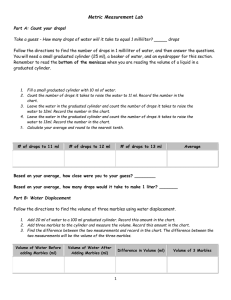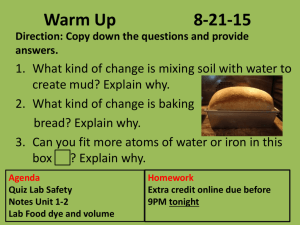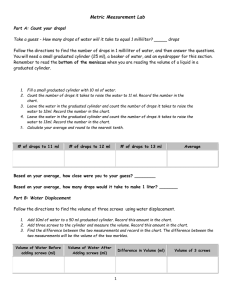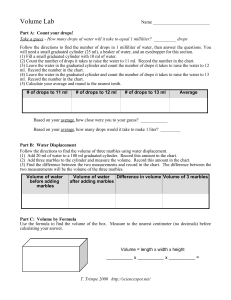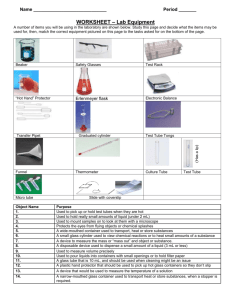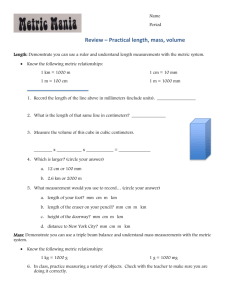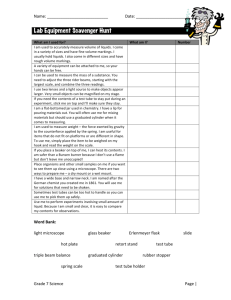Metric-System-Lab
advertisement
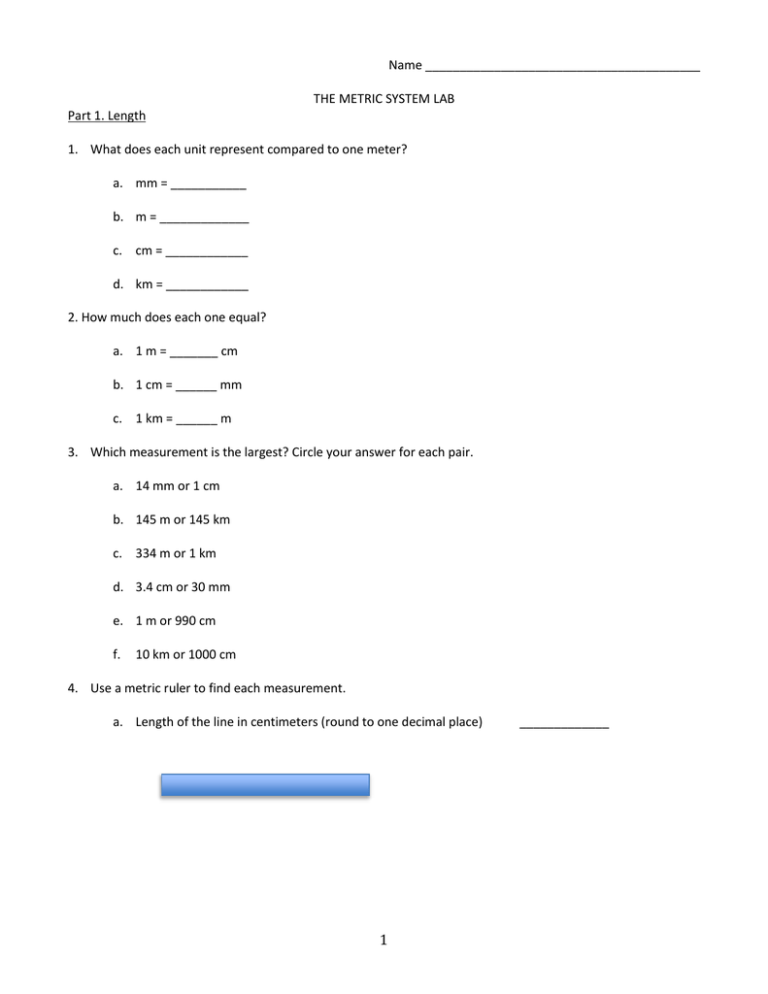
Name ________________________________________ THE METRIC SYSTEM LAB Part 1. Length 1. What does each unit represent compared to one meter? a. mm = ___________ b. m = _____________ c. cm = ____________ d. km = ____________ 2. How much does each one equal? a. 1 m = _______ cm b. 1 cm = ______ mm c. 1 km = ______ m 3. Which measurement is the largest? Circle your answer for each pair. a. 14 mm or 1 cm b. 145 m or 145 km c. 334 m or 1 km d. 3.4 cm or 30 mm e. 1 m or 990 cm f. 10 km or 1000 cm 4. Use a metric ruler to find each measurement. a. Length of the line in centimeters (round to one decimal place) 1 _____________ b. Radius of the circle to in millimeters (round to one decimal place) 5. Find the length of a board marker in millimeters. _____________ _____________ 6. What is your height in centimeters? ____________ 7. What is your height in meters? ____________ 8. Use your shoe and a metric ruler to complete this section. a. What is the length of your shoe to the nearest centimeter? __________ b. How many shoes would it take (heel to toe) to make 1 meter? __________ c. How many shoes would it take to make 1 kilometer? __________ 9. Use ten pennies and a metric ruler to complete this section. a. How tall is a stack of ten pennies in centimeters? __________ b. How tall would a stack of 100 pennies be in centimeters? __________ c. How tall would a stack of 1000 pennies be in centimeters? _________ 10. Circle the BEST metric unit for each. a. The length of an eyelash mm cm m km b. The height of a flagpole mm cm m km c. The distance from Chicago, IL, to Peoria, IL. mm cm m km 11. The meter is defined as the _______________ traveled by _______________ in absolute vacuum in 1⁄299,792,458 of a second. Part 2. Mass 1. Circle the BEST metric unit for each. a. Your mass mg g kg b. Amount of spices in a batch of cookies mg g kg c. Mass of 10 pennies mg g kg 2 2. Which is larger? Circle your choice for each one. a. 1 pound or 100 grams b. 1 kilogram or 1 pound c. 1 ounce or 1000 milligrams 3. 1 lb = _____________ g 4. 100 kg = ____________ lb 5. 1 oz = _____________ mg 6. A kilogram is equal to the mass of the __________________ ________________ ______________ 7. Complete each statement. a. 1 kg = ___________ g b. 1 g = __________ mg 10. Which is larger? Circle your choice for each one. a. 1 kilogram or 1500 grams b. 12 milligrams or 12 kilograms c. 1200 milligrams or 1 gram d. 4 kilograms or 4500 grams 11. Pick an object from the counter and determine its mass. Name of object _____________ Mass _____________ Part 3. Volume 1. Take a guess - How many drops of water will it take to equal 1 milliliter? __________ drops. Follow the directions to find the number of drops in 1 milliliter of water, then answer the questions. Materials: 25 ml graduated cylinder Beaker of water Eyedropper. a. Fill a small graduated cylinder with 10 ml of water. 3 b. Count the number of drops it takes to raise the water to 11 ml. Record the number in the table. c. Leave the water in the graduated cylinder and count the number of drops it takes to raise the water to 12 ml. Record the number in the table. d. Leave the water in the graduated cylinder and count the number of drops it takes to raise the water to 13 ml. Record the number in the table. e. Calculate your average and round to the nearest tenth. f. Based on your average, how close were you to your guess in number of drops? Based on your average, how many drops would it take to make 1 liter? _________ Drops to get to 11 ml Drops to get to 12 ml Drops to get to 13 ml Average 2. Water Displacement. Follow the directions to find the volume of three marbles using water displacement. a. Add 20 ml of water to a 100 ml graduated cylinder. b. Add three marbles to the cylinder and measure the volume. Record this amount in the chart. c. Find the difference between the two measurements and record in the chart. The difference between the two measurements will be the volume of the three marbles. Volume of water without marbles Volume of water with marbles Difference 3. Which is larger? Circle your choice for each one. a. 1 liter or 1 gallon b. 1 liter or 1 quart c. 1 milliliter or 1 fluid ounce 4. Complete each statement. a. 1 gallon = _________ liters b. 1 fl oz = __________ ml c. 1 quart = _________ liters d. 1 L = ______________ mL 4 e. 1 mL = ______ cm3 (or cc) 5. Which is larger? Circle your choice for each one. a. 1 liter or 1500 milliliters b. 200 milliliters or 1.2 liters 6. What is the name of the curve you see at the top of a liquid in a cylinder? _____________________ 7. Does one measure volume from the SIDES or the BOTTOM of the curve? (circle one) 8. What is the volume of liquid in each cylinder? A. _________________ B. _________________ OPTIONAL. Color Challenge. See if your final color matches the answer key. Precise measurements required. Materials 3 beakers with colored water- 25 ml of each color (red, blue, and yellow) 1 graduated cylinder (25 ml - 50 ml) 1 eyedropper 6 test tubes labeled A, B, C, D, E, F Perform each step outlined below using accurate measurements, completing the table as you go. a. Measure 17 ml of RED water from the beaker and pour into test tube A. b. Measure 21 ml of YELLOW water from the beaker and pour into test tube C. c. Measure 22 ml of BLUE water from the beaker and pour into test tube E. d. Measure 5 ml of water from test tube A and pour it into test tube B. e. Measure 6 ml of water from test tube C and pour it into test tube D. f. Measure 8 ml of water from test tube E and pour it into test tube F. g. Measure 5 ml of water from test tube C and pour it into test tube B. h. Measure 2 ml of water from test tube A and pour it into test tube F. i. Measure 4 ml of water from test tube E and pour it into test tube D. 5 Test Tube A B C D E F Color Final Volume 6
